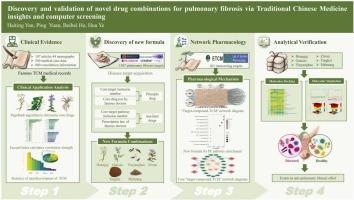通过中医见解和计算机筛选发现和验证肺纤维化的新药物组合
IF 3.1
4区 生物学
Q2 BIOLOGY
引用次数: 0
摘要
肺纤维化是一种严重威胁人类健康的慢性肺间质性疾病。中药的多靶点作用和良好的安全性为治疗提供了新的可能性。方法采用临床专业知识、计算机辅助药物设计(CADD)和中医归经理论相结合的新方剂发现策略。通过分子对接和分子动力学模拟验证了中药与疾病靶点之间的相互作用。此外,新发现的配方与改善肠道菌群变化的相关性证明了它们的功效。结果名医使用的核心药物为黄芪,共获得69组含黄芪的中药对。以肺、心、脾经络为筛选条件,结合疾病靶点和化合物的研究,确定了黄芪甘草、黄芪阴阳火、黄芪子丸、黄芪汀理子、黄芪麻黄对为潜在新方剂的组成成分。95种分子对接配合物均表现出良好的结合能(ΔG≤- 5.0 kcal/mol),进一步确定了分子动力学稳定性。此外,这些草药还可能通过调节肠道菌群组成,增加Akkermansia丰度,改善烟酸盐和烟酰胺代谢来抗肺纤维化。结论建立了中药-桂京- cadd一体化框架,可用于抗纤维化药物联合的精准发现。该策略综合了临床经验、CADD和簋经理论,为精准应用中医治疗复杂疾病提供了理论支持。本文章由计算机程序翻译,如有差异,请以英文原文为准。

Discovery and validation of novel drug combinations for pulmonary fibrosis via Traditional Chinese Medicine insights and computer screening
Background
Pulmonary fibrosis is a chronic interstitial lung disease that poses a serious threat to human health. The multi-target actions and favorable safety profile of Traditional Chinese Medicine (TCM) offer new therapeutic possibilities.
Methods
We implemented an integrated strategy combining clinical expertise, computer-aided drug design (CADD), and TCM GuiJing theory for novel formula discovery. The interactions between TCM and disease targets were verified by molecular docking and molecular dynamics (MD) simulations. Furthermore, the efficacy of the newly discovered formulas was demonstrated by their correlation with ameliorated changes in the intestinal flora.
Results
The core medicines used by famous doctors was Huangqi, and 69 groups of Huangqi-containing herb pairs were obtained. Using lung, heart, and spleen meridians as screening conditions, and by integrating the study of disease targets and compounds, the Huangqi-Gancao, Huangqi-Yinyanghuo, Huangqi-Ziwan, Huangqi-Tinglizi, and Huangqi-Mahuang pairs were identified as components of the potential new formula. All 95 molecular docking complexes exhibited favorable binding energies (ΔG ≤ −5.0 kcal/mol), and molecular dynamics stability was further determined. Moreover, these herbs may also be anti-pulmonary fibrosis by modulating the composition of gut microbiota, increasing Akkermansia abundance, and improving nicotinate and nicotinamide metabolism.
Conclusion
We establish an integrated TCM-GuiJing-CADD framework for the precision discovery of anti-fibrotic drug combinations. This strategy synthesizes clinical experience, CADD, and the GuiJing theory, providing a theoretical support for the precise application of TCM in treating complex diseases.
求助全文
通过发布文献求助,成功后即可免费获取论文全文。
去求助
来源期刊

Computational Biology and Chemistry
生物-计算机:跨学科应用
CiteScore
6.10
自引率
3.20%
发文量
142
审稿时长
24 days
期刊介绍:
Computational Biology and Chemistry publishes original research papers and review articles in all areas of computational life sciences. High quality research contributions with a major computational component in the areas of nucleic acid and protein sequence research, molecular evolution, molecular genetics (functional genomics and proteomics), theory and practice of either biology-specific or chemical-biology-specific modeling, and structural biology of nucleic acids and proteins are particularly welcome. Exceptionally high quality research work in bioinformatics, systems biology, ecology, computational pharmacology, metabolism, biomedical engineering, epidemiology, and statistical genetics will also be considered.
Given their inherent uncertainty, protein modeling and molecular docking studies should be thoroughly validated. In the absence of experimental results for validation, the use of molecular dynamics simulations along with detailed free energy calculations, for example, should be used as complementary techniques to support the major conclusions. Submissions of premature modeling exercises without additional biological insights will not be considered.
Review articles will generally be commissioned by the editors and should not be submitted to the journal without explicit invitation. However prospective authors are welcome to send a brief (one to three pages) synopsis, which will be evaluated by the editors.
 求助内容:
求助内容: 应助结果提醒方式:
应助结果提醒方式:


